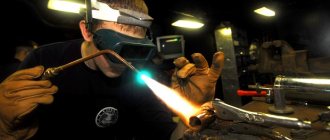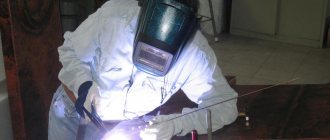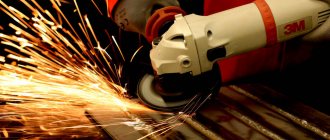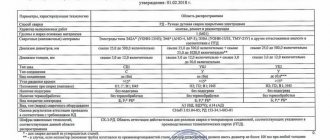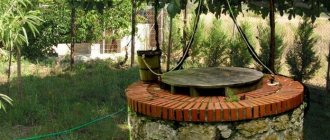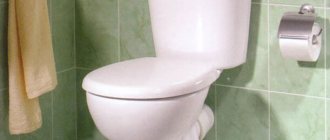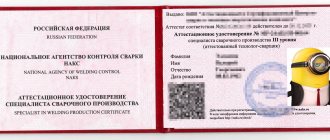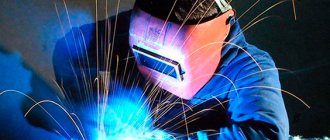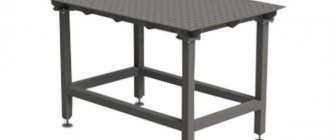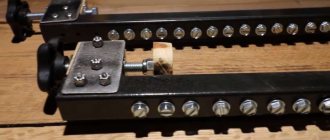Qualities and skills
The welding profession is considered very difficult.
Despite the fact that the state provides equal rights for both sexes, women rarely engage in welding work, since it is associated with high physical stress and a large number of harmful factors. Before being hired, whether in the housing and communal services sector or in a heavy industry enterprise, the applicant must undergo a medical examination, the results of which will determine his suitability for the vacant position. Modern requirements for physical condition are quite high - even minor health problems can cause refusal.
The welder must have the following qualities:
- perseverance and hard work;
- stable physical and psychological condition;
- no fear of heights;
- high level of visual perception;
- ability to be in an uncomfortable position for a long time;
- accuracy and self-demandingness.
The above qualities are very important, because the working conditions are not comfortable: welding is performed at any time of the year and at different heights without the possibility of a convenient location.
Specialist tools and accessories
The list of working equipment depends on the welding mode . For example, when performing argon-arc work, it is necessary to use a cylinder with technical gas, including a shut-off valve with a conical thread and a pressure gauge to regulate the pressure.
In addition to argon workers, gas-electric welders and specialists who perform work in semi-automatic mode are associated with technical gas. The former use gas to heat the surface to a given temperature, and the latter use gas to protect the hot seam from interaction with the environment.
However, the most common type of connection is manual arc welding. To complete the work you will need the following accessories:
- Welding machine . Previously, only transformer-type units were used. They have been replaced by rectifiers and inverters, which have better technical characteristics.
- Electrode holder . The main parameter of the device is the maximum welding current. For household work, this figure will not exceed 200-250 A.
- Cable set . To connect the device to the power supply and transmit an electrical discharge from the current source to the electrode. The latter is subject to special requirements due to high loads during operation. As a rule, this is a copper cable with double insulation and a cross-sectional area of at least 25 mm2.
- Mask . Protects the worker's vision. In simple models, this function is performed by ordinary tinted glass. For professional work, a chameleon-type mask with protective light filters powered by batteries is used.
- Workwear . The welder's work clothes must be resistant to temperature changes so that splashes of molten metal cannot get on the skin. The same applies to shoes and protective gloves or mittens.
- Tools for finishing the seam : metal brushes, hammer and chisel.
III. Rights
3.1. Get acquainted with draft decisions of the organization’s management concerning its activities.
3.2. Request personally or on behalf of the immediate supervisor from the heads of the organization’s departments and specialists information and documents necessary to perform his job duties.
3.3. Submit proposals for improvement of work related to the responsibilities provided for in these instructions for consideration by management.
3.4. Within your competence, inform your immediate supervisor about all shortcomings identified in the course of your activities and make proposals for their elimination.
3.5. Demand that the management of the organization provide assistance in the performance of his labor duties and rights provided for in these instructions.
3.6. Make decisions within your competence.
3.7. (other employee rights).
Difficulties of the work
The specifics of welding depend on the properties of the base metal and the spatial location of the seam . Materials have different thermal conductivity, which leaves its mark on the process of their connection. Violations of technology can lead to the following defects:
- cracks;
- chips;
- surges;
- cavities;
- burns;
- undercuts.
When working with load-bearing metal structures of critical construction projects, the above disadvantages are the reason for mechanical removal of the seam and requirements for re-joining. Some defects are identified by visual inspection of the solidified metal; for others, non-destructive testing methods are used that examine the internal structure of the welded area.
The responsibilities of the welder include the process of studying the structure of the seam upon completion of the work and eliminating all identified deficiencies.
II. Job responsibilities
2.1.1. Familiarization with design and production-technological documentation for welding.
2.1.2. Checking the functionality and serviceability of welding equipment.
2.1.3. Cleaning of structural elements (products, assemblies, parts) with a tool for welding.
2.1.4. Selecting the spatial position of the weld for welding structural elements (products, assemblies, parts).
2.1.5. Assembly of structural elements (products, assemblies, parts) for welding, incl. on tacks, using assembly devices.
2.1.6. Inspection using a measuring tool of prepared and assembled structural elements (products, assemblies, parts) using assembly devices for compliance of geometric dimensions with the requirements of design and production-technological documentation for welding.
2.1.7. Cleaning of welds after welding.
2.1.8. Removal of surface defects (pores, slag inclusions, undercuts, metal splashes, sagging, etc.).
2.2. Welding (surfacing), incl. gas, manual arc welding (surfacing, cutting) with a consumable coated electrode (CD) of structural parts and a non-consumable electrode in a shielding gas (RAD) of structural parts, mechanized welding (surfacing) by fusion of structural parts, manual welding with an external heating source (welding with heated gas (NG), welding with a heated tool (NI), extrusion welding (E)) of structural parts made of polymer materials (plastics, polyethylene, polypropylene, etc.), thermite welding of structural parts.
2.2.1. Checking the equipment of the welding station.
2.2.2. Preparation, checking the functionality and serviceability of welding equipment, welding station and welding materials, checking the presence of grounding of the welding station and equipment, checking the completeness of technological equipment and materials for welding, preparing components for welding, preparing parts for welding.
2.2.3. Setting up welding (surfacing) equipment, setting up equipment for welding, installing parts to be welded with subsequent control, testing.
2.2.4. Performing preliminary and concomitant (interlayer) heating of the metal.
2.2.5. Performing welding (surfacing), cutting parts and structures.
2.2.6. Inspection of welded (surfaced) parts using a measuring tool for compliance of geometric dimensions with the requirements of design and production-technological documentation for welding.
2.2.7. Dismantling of technological equipment.
2.3. Welding (surfacing, cutting), incl. gas, manual arc welding (surfacing, cutting) with a consumable coated electrode (CD), non-consumable electrode in a shielding gas (RAD) and plasma arc welding (surfacing, cutting) (P), mechanized welding (surfacing) by fusion, thermite welding (T) , manual welding with an external heat source (welding with heated gas (NG), welding with a heated tool (TI), extrusion welding (E)) of structures (equipment, products, assemblies, pipelines, parts) from various materials (steels, cast iron, non-ferrous metals and alloys) designed to work under pressure, under static, dynamic and vibration loads.
2.3.1. Checking the functionality and serviceability of welding equipment, setting up welding equipment.
2.3.2. Welding (surfacing) of structures.
2.3.3. Performing welding operations using structural welding technology using specialized functions (capabilities) of welding equipment, incl. in chambers with a controlled atmosphere.
2.3.4. Performing metal cutting.
2.3.5. Inspection of welded structures using a measuring tool for compliance of geometric dimensions with the requirements of design and production-technological documentation for welding.
2.3.6. Correction of defects by welding.
2.4. Installation of structures.
Fire prevention measures
A by-product of the welding process, molten metal spatter, can cause a fire . According to the requirements of fire safety standards, the production site must have fire extinguishing equipment:
- fire extinguisher;
- buckets;
- shovels;
- sand.
Technical gases pose a high risk.
Acetylene, propane, hydrogen require special attention. Acetylene can ignite from the slightest spark, so generators for the synthesis of this gas are placed at a considerable distance from the work site. Propane leaks can also cause a fire. Hydrogen, when in contact with oxygen, forms an explosive mixture, since the process of water formation is accompanied by the release of a large amount of energy, which poses a great danger in the open air.
Semi-automatic welding is considered the safest joining method. The melt zone is protected by an inert gas, and the formation of a seam is accompanied by a minimal amount of splashes of molten metal.
Job description
Each enterprise that employs welders is required to develop special instructions regulating the hiring and activities of employees during work. The main document that must be followed when developing instructions is the professional standard approved by the Ministry of Labor and Social Protection. Let's consider the basic requirements for the profession in question.
Knowledge
In addition to professional skills, during the training process the welder receives the following knowledge:
- Design features of various welding equipment, as well as methods of servicing the main types of devices and rules for their safe operation.
- Physical and chemical properties of basic metals and alloys used in industry. This is necessary to select the optimal parameters of the welding unit to obtain a high-quality seam.
- Methods for preparing parts for joining, including edge removal.
- Have an understanding of corrosion processes and factors influencing its development.
- Types of welding joints and their scope.
- Temperature conditions of connection for base metals and alloys based on them.
- Methods for checking the quality of the finished connection.
- Methods for finishing seam cleaning.
Responsibilities
The range of functional responsibilities of a worker is limited by the job description, subject to its compliance with the requirements of current legislation.
The list of job responsibilities of a welder depends on the level of training. The main responsibilities of a welder are:
- Carrying out preparatory procedures before welding. At the end of the work, the welder is obliged to clean the seam from slag and perform finishing processing.
- Check the serviceability of entrusted equipment and maintain its functionality.
- All work is carried out in accordance with design and technical documentation. The welder is personally responsible for the quality and reliability of the connection made.
- If defects are identified, measures must be taken to eliminate them immediately.
- Pass periodic knowledge tests on labor protection and fire safety. Typically, the interval between inspections is one year.
- Undergo a medical examination within the time limits established by law.
- Comply with the internal regulations in force at the enterprise.
Rights of an electric welder for manual welding
In addition to the duties, the welder has rights, the list of which is established by the instructions:
- The main right is the opportunity to refuse to perform work in conditions that do not meet the requirements of regulatory documents on labor protection.
- Do not start work if faults are detected in the welding equipment.
- Require authorized persons of the enterprise to assist in the performance of immediate duties.
- Timely receipt of special clothing and personal protective equipment.
- Study documentation that is relevant to the performance of duties.
- Suggest ways to improve the production process.
- Increase your qualification level.
Responsibility
In some cases, the welder may be subject to disciplinary, administrative or criminal liability, depending on the type of violation:
- Improper performance of one's duties or performance of them not in full.
- Violations of internal labor regulations, safety regulations or labor protection requirements of the enterprise.
- Committing acts provided for by the administrative, civil or criminal code in force on the territory of the Russian Federation.
- Causing intentional damage to entrusted equipment.
- Disclosure of confidential company information.
I. General provisions
1.2. The hiring and dismissal of an electric and gas welder is carried out by order of the head of the organization upon presentation.
1.3. The electric and gas welder reports directly.
1.4. A person with education and at least years of work experience is hired to work as an electric and gas welder.
1.5. An electric gas welder must know:
- main types, structural elements and dimensions of welded joints performed by thermite welding, performed by gas welding (surfacing) by fusion, performed by RD, performed by RAD, performed by NG, NI and E and their designation in the drawings;
- main types, structural elements and dimensions of welded joints performed by gas welding (surfacing) by melting complex and critical structures (terminals for electrochemical protection of pipelines for various purposes made of carbon and structural steels, electrical wires of power lines at heights and in high voltage zones, etc. .), performed by thermite welding, performed by RD, performed by RAD and P, performed by NG, NI and E of complex and critical structures;
— rules for preparing the edges of products for welding;
- main groups and grades of materials and critical structures welded by gas welding (surfacing), welded by RD, welded by RAD and P, welded by thermite welding, welded by NG, NI and E, welded by mechanized welding (surfacing) by fusion, welded by NG, NI and E ;
— welding (surfacing) materials for gas welding (surfacing), for RD, for RAD, for RAD and P, for mechanized welding (surfacing) by fusion, for thermite welding (soldering and welding rods, thermite mixture), refractory and molding materials, foundry components of thermite mixture, for NG, NI and E, incl. complex and critical structures;
— main types and devices for exciting and stabilizing the welding arc (welding oscillators);
— arrangement of welding and auxiliary equipment for gas welding (surfacing), for RD, for RAD, for P, for mechanized fusion welding (surfacing), for NG, NI and E welding, the purpose and operating conditions of instrumentation, rules for their operation and scope of application;
